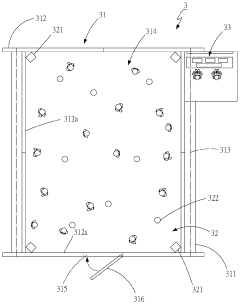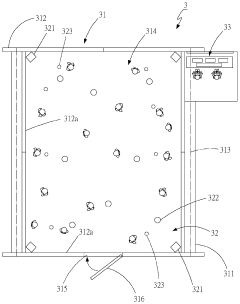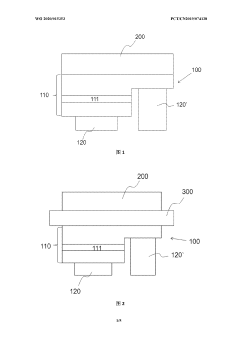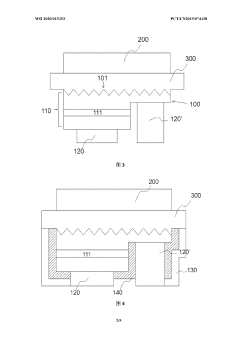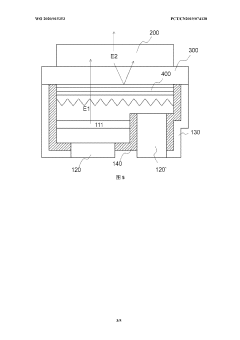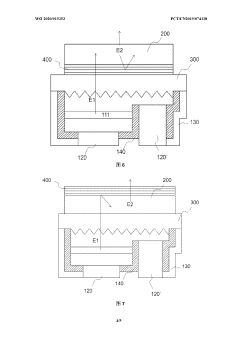ULED: Pioneering the Future of Entertainment Spaces
JUN 20, 20259 MIN READ
Generate Your Research Report Instantly with AI Agent
Patsnap Eureka helps you evaluate technical feasibility & market potential.
ULED Technology Evolution
ULED technology has undergone a remarkable evolution since its inception, marking significant milestones in the development of entertainment spaces. The journey began with the introduction of LED displays, which offered improved brightness and energy efficiency compared to traditional lighting solutions. As the technology progressed, manufacturers focused on enhancing pixel density and color accuracy, leading to the development of high-resolution LED screens capable of delivering stunning visual experiences.
The next major leap came with the integration of ultra-high-definition (UHD) capabilities into LED displays. This advancement allowed for the creation of massive screens with unprecedented clarity and detail, revolutionizing the way content is presented in large venues such as stadiums, concert halls, and theme parks. The introduction of HDR (High Dynamic Range) technology further elevated the visual quality, providing deeper blacks, brighter whites, and a wider color gamut.
As ULED technology continued to evolve, researchers and engineers turned their attention to improving viewing angles and reducing the visible pixel structure. This led to the development of micro-LED and mini-LED technologies, which utilize extremely small LED chips to create displays with even higher resolution and better uniformity. These advancements have been crucial in enabling the creation of seamless, immersive environments that blur the line between physical and digital spaces.
Another significant milestone in ULED evolution has been the incorporation of flexible and modular designs. This innovation has allowed for the creation of curved and unconventional display shapes, opening up new possibilities for architectural integration and creative expression in entertainment venues. The modular nature of modern ULED systems also facilitates easier maintenance and upgrades, ensuring that installations can remain cutting-edge for longer periods.
Recent developments in ULED technology have focused on enhancing interactivity and responsiveness. The integration of touch-sensitive surfaces and motion-tracking capabilities has transformed passive displays into interactive canvases, enabling new forms of audience engagement and participatory experiences. Additionally, advancements in real-time rendering and content management systems have made it possible to create dynamic, adaptive environments that respond to user inputs, environmental conditions, or pre-programmed scenarios.
Looking ahead, the future of ULED technology in entertainment spaces is poised for further innovation. Research is ongoing in areas such as transparent displays, holographic projections, and seamless integration with augmented reality systems. These developments promise to push the boundaries of what is possible in immersive entertainment, creating even more captivating and transformative experiences for audiences worldwide.
The next major leap came with the integration of ultra-high-definition (UHD) capabilities into LED displays. This advancement allowed for the creation of massive screens with unprecedented clarity and detail, revolutionizing the way content is presented in large venues such as stadiums, concert halls, and theme parks. The introduction of HDR (High Dynamic Range) technology further elevated the visual quality, providing deeper blacks, brighter whites, and a wider color gamut.
As ULED technology continued to evolve, researchers and engineers turned their attention to improving viewing angles and reducing the visible pixel structure. This led to the development of micro-LED and mini-LED technologies, which utilize extremely small LED chips to create displays with even higher resolution and better uniformity. These advancements have been crucial in enabling the creation of seamless, immersive environments that blur the line between physical and digital spaces.
Another significant milestone in ULED evolution has been the incorporation of flexible and modular designs. This innovation has allowed for the creation of curved and unconventional display shapes, opening up new possibilities for architectural integration and creative expression in entertainment venues. The modular nature of modern ULED systems also facilitates easier maintenance and upgrades, ensuring that installations can remain cutting-edge for longer periods.
Recent developments in ULED technology have focused on enhancing interactivity and responsiveness. The integration of touch-sensitive surfaces and motion-tracking capabilities has transformed passive displays into interactive canvases, enabling new forms of audience engagement and participatory experiences. Additionally, advancements in real-time rendering and content management systems have made it possible to create dynamic, adaptive environments that respond to user inputs, environmental conditions, or pre-programmed scenarios.
Looking ahead, the future of ULED technology in entertainment spaces is poised for further innovation. Research is ongoing in areas such as transparent displays, holographic projections, and seamless integration with augmented reality systems. These developments promise to push the boundaries of what is possible in immersive entertainment, creating even more captivating and transformative experiences for audiences worldwide.
Market Demand Analysis
The market demand for ULED (Ultra Light Emitting Diode) technology in entertainment spaces is experiencing significant growth, driven by the increasing consumer appetite for immersive and high-quality visual experiences. As the entertainment industry continues to evolve, there is a growing need for advanced display technologies that can deliver superior image quality, energy efficiency, and versatility.
The global entertainment and media market, which includes sectors such as theme parks, cinemas, and live events, is projected to expand substantially in the coming years. This growth is fueled by rising disposable incomes, urbanization, and the increasing popularity of experiential entertainment. Within this context, ULED technology is poised to capture a significant share of the market due to its ability to enhance visual experiences across various entertainment venues.
One of the key drivers of market demand for ULED in entertainment spaces is the trend towards larger and higher resolution displays. Theme parks, stadiums, and concert venues are increasingly incorporating massive screens to create more engaging and immersive environments for visitors. ULED's ability to deliver exceptional brightness, contrast, and color accuracy makes it an ideal solution for these large-scale applications.
Moreover, the demand for energy-efficient technologies is growing across all industries, including entertainment. ULED's lower power consumption compared to traditional LED displays appeals to venue operators looking to reduce operational costs and improve sustainability. This aligns with the broader industry trend towards green technologies and environmentally responsible practices.
The rise of virtual and augmented reality experiences in entertainment spaces is another factor driving the demand for ULED technology. As these immersive technologies become more prevalent, there is a need for display solutions that can seamlessly integrate with VR and AR systems while maintaining high visual quality. ULED's superior color reproduction and fast response times make it well-suited for these applications.
In the cinema industry, there is a growing interest in alternative display technologies to traditional projection systems. ULED screens offer the potential for brighter, more vibrant images that can enhance the moviegoing experience, particularly in premium formats. This presents a significant market opportunity as cinemas seek to differentiate themselves and attract audiences in an increasingly competitive landscape.
The events and live entertainment sector is also showing strong demand for flexible and modular display solutions. ULED's ability to be configured into various shapes and sizes makes it attractive for stage designs, temporary installations, and touring productions. This versatility allows event organizers to create unique and dynamic visual environments that can adapt to different venues and performances.
The global entertainment and media market, which includes sectors such as theme parks, cinemas, and live events, is projected to expand substantially in the coming years. This growth is fueled by rising disposable incomes, urbanization, and the increasing popularity of experiential entertainment. Within this context, ULED technology is poised to capture a significant share of the market due to its ability to enhance visual experiences across various entertainment venues.
One of the key drivers of market demand for ULED in entertainment spaces is the trend towards larger and higher resolution displays. Theme parks, stadiums, and concert venues are increasingly incorporating massive screens to create more engaging and immersive environments for visitors. ULED's ability to deliver exceptional brightness, contrast, and color accuracy makes it an ideal solution for these large-scale applications.
Moreover, the demand for energy-efficient technologies is growing across all industries, including entertainment. ULED's lower power consumption compared to traditional LED displays appeals to venue operators looking to reduce operational costs and improve sustainability. This aligns with the broader industry trend towards green technologies and environmentally responsible practices.
The rise of virtual and augmented reality experiences in entertainment spaces is another factor driving the demand for ULED technology. As these immersive technologies become more prevalent, there is a need for display solutions that can seamlessly integrate with VR and AR systems while maintaining high visual quality. ULED's superior color reproduction and fast response times make it well-suited for these applications.
In the cinema industry, there is a growing interest in alternative display technologies to traditional projection systems. ULED screens offer the potential for brighter, more vibrant images that can enhance the moviegoing experience, particularly in premium formats. This presents a significant market opportunity as cinemas seek to differentiate themselves and attract audiences in an increasingly competitive landscape.
The events and live entertainment sector is also showing strong demand for flexible and modular display solutions. ULED's ability to be configured into various shapes and sizes makes it attractive for stage designs, temporary installations, and touring productions. This versatility allows event organizers to create unique and dynamic visual environments that can adapt to different venues and performances.
ULED Technical Challenges
ULED technology, while promising, faces several significant technical challenges that need to be addressed for widespread adoption in entertainment spaces. One of the primary hurdles is the development of ultra-high-resolution displays that can maintain image quality at large scales. Current LED technology struggles to achieve pixel densities high enough for seamless viewing experiences in close-proximity applications, such as indoor entertainment venues.
Another major challenge lies in the power consumption and heat dissipation of ULED displays. As resolution and brightness increase, so does the energy demand, leading to potential overheating issues and reduced lifespan of components. Engineers must develop innovative cooling solutions and more energy-efficient LED designs to mitigate these problems.
Color accuracy and consistency across large ULED displays present another technical obstacle. Achieving uniform color reproduction and maintaining it over time requires advanced calibration techniques and sophisticated color management systems. This challenge is particularly crucial in entertainment spaces where visual fidelity is paramount.
The manufacturing process for ULED displays also poses significant challenges. Producing ultra-fine LED chips at scale while maintaining high yield rates and cost-effectiveness is a complex undertaking. Current production methods may not be sufficient to meet the demands of large-scale ULED implementation in entertainment venues.
Durability and longevity of ULED displays in high-use environments like entertainment spaces are additional concerns. These displays must withstand frequent use, potential physical impacts, and varying environmental conditions while maintaining performance over extended periods. Developing robust protective coatings and resilient LED structures is essential to address this challenge.
Integration of ULED technology with existing audio-visual systems and content creation workflows presents another set of technical hurdles. Ensuring compatibility with various content formats, seamless synchronization with audio systems, and real-time rendering capabilities for interactive experiences are critical aspects that require innovative solutions.
Lastly, the challenge of reducing the overall cost of ULED technology remains significant. While prices have decreased over time, ULED displays are still considerably more expensive than traditional display technologies. Overcoming this economic barrier through technological advancements and economies of scale is crucial for widespread adoption in entertainment spaces.
Another major challenge lies in the power consumption and heat dissipation of ULED displays. As resolution and brightness increase, so does the energy demand, leading to potential overheating issues and reduced lifespan of components. Engineers must develop innovative cooling solutions and more energy-efficient LED designs to mitigate these problems.
Color accuracy and consistency across large ULED displays present another technical obstacle. Achieving uniform color reproduction and maintaining it over time requires advanced calibration techniques and sophisticated color management systems. This challenge is particularly crucial in entertainment spaces where visual fidelity is paramount.
The manufacturing process for ULED displays also poses significant challenges. Producing ultra-fine LED chips at scale while maintaining high yield rates and cost-effectiveness is a complex undertaking. Current production methods may not be sufficient to meet the demands of large-scale ULED implementation in entertainment venues.
Durability and longevity of ULED displays in high-use environments like entertainment spaces are additional concerns. These displays must withstand frequent use, potential physical impacts, and varying environmental conditions while maintaining performance over extended periods. Developing robust protective coatings and resilient LED structures is essential to address this challenge.
Integration of ULED technology with existing audio-visual systems and content creation workflows presents another set of technical hurdles. Ensuring compatibility with various content formats, seamless synchronization with audio systems, and real-time rendering capabilities for interactive experiences are critical aspects that require innovative solutions.
Lastly, the challenge of reducing the overall cost of ULED technology remains significant. While prices have decreased over time, ULED displays are still considerably more expensive than traditional display technologies. Overcoming this economic barrier through technological advancements and economies of scale is crucial for widespread adoption in entertainment spaces.
Current ULED Solutions
01 ULED structure and fabrication
Ultra Light Emitting Diodes (ULEDs) are advanced semiconductor devices designed for high-efficiency light emission. The structure typically includes multiple layers of semiconductor materials, such as quantum wells and barrier layers, optimized for enhanced light output. Fabrication techniques may involve epitaxial growth methods and precise control of layer thicknesses to achieve desired optical and electrical properties.- ULED structure and fabrication: Ultra Light Emitting Diodes (ULEDs) are advanced semiconductor devices designed for high-efficiency light emission. The structure typically includes multiple layers of semiconductor materials, such as quantum wells and barrier layers, optimized for enhanced light output. Fabrication techniques may involve epitaxial growth methods and precise control of material composition to achieve desired emission characteristics.
- Light extraction and efficiency improvement: Various techniques are employed to improve light extraction and overall efficiency of ULEDs. These may include surface texturing, use of photonic crystals, and optimization of device geometry. Advanced packaging methods and heat management strategies are also implemented to enhance performance and longevity of the devices.
- Color tuning and phosphor integration: ULEDs can be designed to emit light at specific wavelengths or to produce white light through color mixing. This often involves the integration of phosphor materials or the use of multiple emitting layers. Techniques for precise color control and uniform phosphor distribution are crucial for achieving desired color rendering and consistency.
- Driving and control systems: Advanced driving and control systems are developed for ULEDs to optimize their performance and enable dynamic lighting applications. These may include pulse-width modulation techniques, intelligent thermal management, and integration with smart control systems for adjustable brightness and color temperature.
- Applications in displays and lighting: ULEDs find applications in high-resolution displays, automotive lighting, and general illumination. Their small size, high efficiency, and excellent color quality make them suitable for micro-LED displays and advanced lighting fixtures. Integration with flexible substrates and novel form factors enables new possibilities in wearable and architectural lighting designs.
02 Light extraction techniques
Various methods are employed to improve light extraction efficiency in ULEDs. These may include surface texturing, use of photonic crystals, or incorporation of nanostructures to reduce total internal reflection and increase light output. Advanced packaging techniques and optical designs are also utilized to maximize the external quantum efficiency of the devices.Expand Specific Solutions03 Phosphor integration for color conversion
ULEDs often incorporate phosphor materials for color conversion, allowing for the production of white light or specific color temperatures. The phosphor can be applied directly on the LED chip or integrated into the packaging. Optimization of phosphor composition, particle size, and distribution is crucial for achieving high color rendering and uniform light emission.Expand Specific Solutions04 Thermal management solutions
Effective thermal management is critical for ULED performance and longevity. Advanced heat dissipation techniques, such as the use of high thermal conductivity substrates, improved package designs, and integration of heat spreaders, are employed to maintain optimal operating temperatures and prevent efficiency droop at high current densities.Expand Specific Solutions05 Novel materials and quantum structures
Research in ULEDs focuses on developing novel materials and quantum structures to enhance performance. This includes the exploration of wide bandgap semiconductors, quantum dots, and nanowire structures. These innovations aim to improve internal quantum efficiency, reduce defect densities, and enable emission at new wavelengths for various applications in lighting and displays.Expand Specific Solutions
Key ULED Industry Players
The ULED (Ultra Light Emitting Diode) technology for entertainment spaces is in its early growth stage, with a rapidly expanding market driven by increasing demand for immersive experiences. The global market size for this technology is projected to grow significantly in the coming years. While the technology is still evolving, major players like Samsung Electronics, LG Electronics, and Universal Display Corp. are at the forefront of development, investing heavily in R&D. Emerging companies such as eLux and Nanolumens are also making strides in innovation. The technology's maturity varies, with established firms having more advanced solutions, while newer entrants are focusing on niche applications and improvements in specific aspects of ULED technology.
Samsung Electronics Co., Ltd.
Technical Solution: Samsung has developed a revolutionary ULED (Ultra Light Emitting Diode) technology for entertainment spaces. This technology combines the benefits of LED and OLED, offering superior brightness, contrast, and color accuracy. Samsung's ULED displays use a unique micro-LED structure with quantum dot enhancement, allowing for precise control over each pixel. The displays are modular and scalable, making them suitable for various entertainment venues, from small theaters to large stadiums. Samsung's ULED technology also incorporates advanced local dimming algorithms and HDR processing to deliver an immersive viewing experience with deep blacks and vibrant colors.
Strengths: Exceptional picture quality, scalability, and energy efficiency. Weaknesses: High initial cost and complexity in installation and maintenance.
LG Electronics, Inc.
Technical Solution: LG's approach to ULED technology focuses on creating seamless, large-scale displays for entertainment spaces. Their solution utilizes a proprietary ULED panel design that combines ultra-fine LED pixels with advanced color filters and light management systems. LG's ULED displays feature a unique heat dissipation structure that allows for higher brightness levels without compromising longevity. The company has also developed a specialized content management system that optimizes visual content for ULED displays, ensuring that entertainment venues can fully leverage the technology's capabilities. LG's ULED displays incorporate AI-powered image processing to enhance picture quality and adapt to ambient lighting conditions in real-time.
Strengths: High brightness capabilities and advanced content optimization. Weaknesses: Limited flexibility in display shapes and sizes compared to some competitors.
ULED Core Innovations
Immersive LED display theater system
PatentActiveTW202320541A
Innovation
- Integration of LED display screens on multiple walls to create a fully immersive 360-degree visual experience.
- Combination of visual, audio, and lighting elements controlled by a central system for a synchronized immersive experience.
- Mobility feature allowing the entire theater system to be transported and set up in different locations.
Micro light emitting device and display thereof
PatentWO2020015353A1
Innovation
- Using a micro-light-emitting diode structure with a transparent adhesive layer, the blue/green light is converted into red light through photon conversion technology, the AlInGaP-based quantum well layer is used to achieve efficient photon conversion, and anti-reflection and anti-reflection are set on the micro-light-emitting diode. The film layer and light reflective layer optimize the light emission efficiency.
ULED Content Ecosystem
The ULED Content Ecosystem is a critical component in the successful implementation and adoption of ULED technology in entertainment spaces. This ecosystem encompasses a wide range of content creators, distributors, and platforms that are essential for delivering immersive and engaging experiences to audiences.
At the core of the ULED Content Ecosystem are the content creators, including film studios, game developers, and digital artists. These creators are adapting their workflows to take full advantage of ULED's superior color gamut, contrast ratios, and resolution. This involves developing new techniques for color grading, visual effects, and 3D rendering that can fully exploit the capabilities of ULED displays.
Content distributors play a crucial role in ensuring that ULED-optimized content reaches the intended audience. Streaming platforms, broadcasters, and digital content marketplaces are upgrading their infrastructure to support the higher bandwidth requirements of ULED content. This includes implementing advanced compression algorithms and adaptive streaming technologies to deliver high-quality ULED content across various network conditions.
The ULED Content Ecosystem also includes specialized content creation tools and software. These tools are designed to help creators visualize and produce content that maximizes the potential of ULED displays. From color management systems to real-time rendering engines, these tools are evolving to support the unique requirements of ULED content production.
Another key aspect of the ecosystem is the development of standards and formats specific to ULED content. Industry consortiums and standards bodies are working to establish guidelines for ULED content creation, distribution, and playback. These standards ensure interoperability across different ULED devices and platforms, facilitating a seamless experience for end-users.
The ecosystem extends to content delivery networks (CDNs) and cloud infrastructure providers, who are scaling their capabilities to handle the increased data demands of ULED content. This includes deploying edge computing solutions to reduce latency and improve the delivery of high-resolution, high-frame-rate ULED content.
Furthermore, the ULED Content Ecosystem is fostering collaboration between technology providers and content creators. This partnership is driving innovation in areas such as real-time ray tracing, advanced motion capture, and volumetric video, all of which contribute to creating more immersive ULED experiences.
As the ecosystem matures, we are seeing the emergence of ULED-native content formats and experiences that are designed from the ground up to leverage the technology's capabilities. This includes interactive installations, augmented reality overlays, and multi-view experiences that are only possible with ULED's advanced display properties.
At the core of the ULED Content Ecosystem are the content creators, including film studios, game developers, and digital artists. These creators are adapting their workflows to take full advantage of ULED's superior color gamut, contrast ratios, and resolution. This involves developing new techniques for color grading, visual effects, and 3D rendering that can fully exploit the capabilities of ULED displays.
Content distributors play a crucial role in ensuring that ULED-optimized content reaches the intended audience. Streaming platforms, broadcasters, and digital content marketplaces are upgrading their infrastructure to support the higher bandwidth requirements of ULED content. This includes implementing advanced compression algorithms and adaptive streaming technologies to deliver high-quality ULED content across various network conditions.
The ULED Content Ecosystem also includes specialized content creation tools and software. These tools are designed to help creators visualize and produce content that maximizes the potential of ULED displays. From color management systems to real-time rendering engines, these tools are evolving to support the unique requirements of ULED content production.
Another key aspect of the ecosystem is the development of standards and formats specific to ULED content. Industry consortiums and standards bodies are working to establish guidelines for ULED content creation, distribution, and playback. These standards ensure interoperability across different ULED devices and platforms, facilitating a seamless experience for end-users.
The ecosystem extends to content delivery networks (CDNs) and cloud infrastructure providers, who are scaling their capabilities to handle the increased data demands of ULED content. This includes deploying edge computing solutions to reduce latency and improve the delivery of high-resolution, high-frame-rate ULED content.
Furthermore, the ULED Content Ecosystem is fostering collaboration between technology providers and content creators. This partnership is driving innovation in areas such as real-time ray tracing, advanced motion capture, and volumetric video, all of which contribute to creating more immersive ULED experiences.
As the ecosystem matures, we are seeing the emergence of ULED-native content formats and experiences that are designed from the ground up to leverage the technology's capabilities. This includes interactive installations, augmented reality overlays, and multi-view experiences that are only possible with ULED's advanced display properties.
ULED Energy Efficiency
ULED technology represents a significant leap forward in energy efficiency for entertainment spaces. By leveraging advanced light-emitting diode (LED) technology and innovative control systems, ULED displays offer substantial improvements in power consumption compared to traditional lighting and display solutions.
One of the key factors contributing to ULED's energy efficiency is its precise light control capabilities. Unlike conventional LED systems, ULED can dynamically adjust brightness and color output at a granular level, allowing for optimal energy use based on content and ambient conditions. This results in significant power savings, especially in large-scale installations such as theme parks, stadiums, and concert venues.
The integration of advanced power management systems further enhances ULED's energy efficiency. These systems incorporate intelligent algorithms that analyze usage patterns and environmental factors to optimize power distribution. By minimizing unnecessary energy consumption during low-demand periods or in unoccupied areas, ULED installations can achieve substantial reductions in overall energy usage.
ULED's energy efficiency is also bolstered by its superior heat management properties. The technology employs innovative thermal design techniques that effectively dissipate heat, reducing the need for energy-intensive cooling systems. This not only contributes to lower power consumption but also extends the lifespan of the ULED components, further improving long-term energy efficiency.
Moreover, ULED technology benefits from ongoing advancements in LED manufacturing processes. The latest generation of ULED panels incorporates high-efficiency LED chips that deliver improved lumens per watt ratios. This translates to brighter displays with lower power requirements, enabling entertainment spaces to create stunning visual experiences while minimizing their energy footprint.
The energy efficiency of ULED systems extends beyond direct power consumption. By reducing heat output and minimizing the need for auxiliary cooling systems, ULED installations can contribute to overall energy savings in entertainment venues. This holistic approach to energy efficiency aligns with growing sustainability initiatives in the entertainment industry and helps venues meet increasingly stringent environmental regulations.
As ULED technology continues to evolve, researchers are exploring new avenues to further enhance its energy efficiency. Promising areas of development include the integration of artificial intelligence for predictive power management and the use of advanced materials to improve light extraction and thermal properties. These ongoing innovations suggest that ULED's energy efficiency will continue to improve, solidifying its position as a cornerstone technology for future entertainment spaces.
One of the key factors contributing to ULED's energy efficiency is its precise light control capabilities. Unlike conventional LED systems, ULED can dynamically adjust brightness and color output at a granular level, allowing for optimal energy use based on content and ambient conditions. This results in significant power savings, especially in large-scale installations such as theme parks, stadiums, and concert venues.
The integration of advanced power management systems further enhances ULED's energy efficiency. These systems incorporate intelligent algorithms that analyze usage patterns and environmental factors to optimize power distribution. By minimizing unnecessary energy consumption during low-demand periods or in unoccupied areas, ULED installations can achieve substantial reductions in overall energy usage.
ULED's energy efficiency is also bolstered by its superior heat management properties. The technology employs innovative thermal design techniques that effectively dissipate heat, reducing the need for energy-intensive cooling systems. This not only contributes to lower power consumption but also extends the lifespan of the ULED components, further improving long-term energy efficiency.
Moreover, ULED technology benefits from ongoing advancements in LED manufacturing processes. The latest generation of ULED panels incorporates high-efficiency LED chips that deliver improved lumens per watt ratios. This translates to brighter displays with lower power requirements, enabling entertainment spaces to create stunning visual experiences while minimizing their energy footprint.
The energy efficiency of ULED systems extends beyond direct power consumption. By reducing heat output and minimizing the need for auxiliary cooling systems, ULED installations can contribute to overall energy savings in entertainment venues. This holistic approach to energy efficiency aligns with growing sustainability initiatives in the entertainment industry and helps venues meet increasingly stringent environmental regulations.
As ULED technology continues to evolve, researchers are exploring new avenues to further enhance its energy efficiency. Promising areas of development include the integration of artificial intelligence for predictive power management and the use of advanced materials to improve light extraction and thermal properties. These ongoing innovations suggest that ULED's energy efficiency will continue to improve, solidifying its position as a cornerstone technology for future entertainment spaces.
Unlock deeper insights with Patsnap Eureka Quick Research — get a full tech report to explore trends and direct your research. Try now!
Generate Your Research Report Instantly with AI Agent
Supercharge your innovation with Patsnap Eureka AI Agent Platform!

